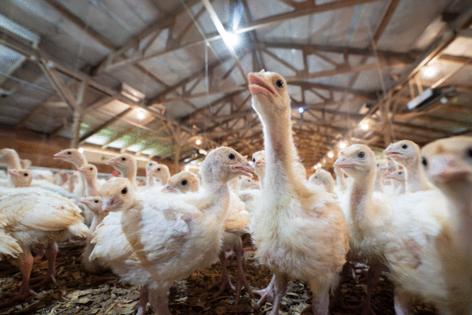Why not vaccinate Minnesota turkeys for bird flu? It could start a trade fight
Published in Business News
Avian flu flared up in Minnesota poultry operations last month after a nearly eight-month reprieve, forcing farmers to depopulate eight turkey barns.
A vaccine exists for this highly pathogenic avian influenza, which could be used against the nearly four-year outbreak that has wiped out 9.2 million birds in Minnesota alone.
But if American chickens and turkeys are vaccinated, other countries may not buy them. The fear among importers is that vaccinated birds might not show symptoms of an infection, allowing the virus to spread across borders undetected.
So the option is off the table until the federal government approves a vaccine and new trade pacts can be negotiated — even though bird flu could prompt a pandemic if the virus mutates and starts spreading broadly among humans.
“Vaccination is caught up in an international kerfuffle, if you will,” said Carol Cardona, a professor in the Department of Veterinary and Biomedical Sciences at the University of Minnesota. “We have vaccines. We have the ability to implement them.”
As frustrating as high egg prices have been for consumers, billions in lost exports would be a much bigger financial setback for the poultry industry. Minnesota is the country’s leading turkey producer. The Thanksgiving staple is a billion-dollar industry in the state, with more than 600 farms.
The U.S. Department of Agriculture has spent $100 million on bird flu vaccine research this year, though the agency hasn’t authorized one for commercial use yet. The USDA is talking to trading partners to make sure virus-fighting efforts don’t impact trade.
“In the meantime, biosecurity remains the best and most prudent approach to mitigate the impact of the disease today,” the agency said in an email.
Nationally, nearly 180 million birds have died from bird flu or were culled to prevent its spread since the outbreak began in spring 2022, according to the USDA. The federal government has paid more than $1.4 billion to poultry owners to compensate them for the lost animals.
In Minnesota, there is support for H5N1 vaccines — so long as they don’t restrict trade.
“Our growers would love to have another tool, like vaccines,” said Ashley Kohls, executive director of the Minnesota Turkey Growers Association. “But we also need and value our export markets, and we need ongoing surveillance.”
It came as no surprise to those who have been tracking the virus that avian influenza returned to Minnesota in September. Migrating waterfowl and other wild birds, which are broadly infected, tend to spark new flu cases when they’re on the move.
What remains a mystery is how the virus gets from wild animals into a commercial flock.
“It’s maddening that we don’t know, because we’re asking farms to do all sorts of things, a lot of which is expensive, some of which is difficult,” said Jennifer Nuzzo, an epidemiologist at Brown University who has been tracking the H5N1 virus on farms.
Some turkey farms in Minnesota have installed bird-deterring lasers, similar to those used at airports, at a cost of about $40,000 per barn, Kohls said.
“We’d rather prevent the disease than respond to it,” she said.
So far, the gold standard of managing the spread of the virus is depopulating a farm, even if it was only found in one barn, said Shauna Voss, assistant director of the Minnesota Board of Animal Health. After that, there’s a quarantine before more birds can be brought back.
Voss said Minnesota poultry flocks will still be in a high-risk period until “snow starts flying.”
The industry wants more solutions to the virus officially known as highly pathogenic avian influenza.
“The silver bullet of ‘Here’s the problem, here’s how to solve it’ is still out there. We’ve got to find it,” said Sherman Miller, CEO of the nation’s largest egg company, Cal-Maine Foods, during a call with investors Oct. 1.
Two egg industry groups produced a report in April suggesting to the USDA that the federal government start planning a vaccination campaign.
The idea is that the United States needs to start explaining to trading partners how it would go about vaccination, said John Clifford, a retired USDA official who was once the agency’s chief veterinary officer.
Other countries may deny vaccinated birds because of a fear that infection could be hiding in the flock, but the animals would not show symptoms, said Clifford, who helped author the egg industry’s report.
“If we’re going to vaccinate, we need time to be able to know that impact,” Clifford said. “If, worst-case scenario, every country shut us off, we (might) lose $6 billion of exports.”
Already the trade impacts of vaccination have been made clear. France moved to vaccinate its ducks from the virus in 2023, a campaign that had helped poultry production there recover. But the U.S. stopped accepting imports of the birds from France until this January.
Clifford estimated that if the United States undertook a vaccination campaign like in France, the vaccines, additional surveillance and an audit program to make sure the virus isn’t lurking in flocks could cost $2 a bird.
And for some, the cost can’t be borne: “The [chicken] broiler industry isn’t going to vaccinate,” he said. “Those birds don’t live long enough, they live six weeks.”
Clifford also stressed that a vaccine won’t completely end the influenza wave, because it will still be circulating in wild birds.
Regardless, Cardona said, many growers would be willing to take on the cost and hassle. Vaccines might be best used on farms that have been hit with the virus repeatedly, even if it isn’t used everywhere, she said.
Vaccination could have other benefits down the line.
Cardona said it would mean “a reduced risk of spread to other species, reduced mutation risk, and reduced spillover risk” to humans.
©2025 The Minnesota Star Tribune. Visit at startribune.com. Distributed by Tribune Content Agency, LLC.












Comments